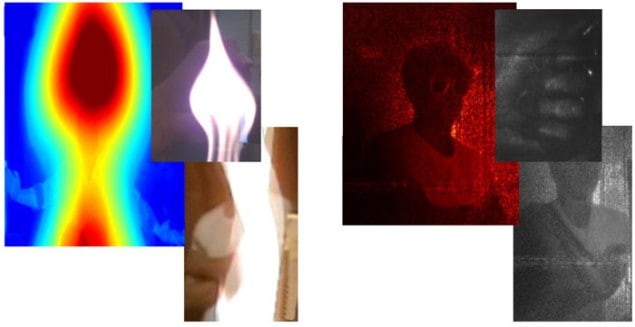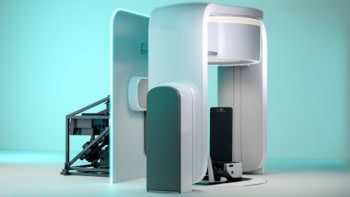
A new method of digital holography with the ability to see clearly through both smoke and flames has been developed by researchers in Italy. The technology, which operates at a far-infrared wavelength, has potential for use in fire rescue situations where existing infrared cameras – while able to see through smoke – are blinded by the radiation given off by flames.
According to the researchers, this problem is caused by the need for a zoom lens within current cameras. It is this that focuses incoming light onto the digital sensor, forming an image. The lens, however, has the undesired effect of also focusing the infrared light emitted from flames, causing the sensor pixels to become saturated. The new imaging technique avoids this problem by switching to a lens-free, holographic system.
Holographic view
Holograms are created by splitting laser beams into two. One part of the light – the object beam – is reflected off of the object being visualized. When this ray is recombined with the other – the reference beam – the ensuing interference pattern encodes a 3D image of the target object.
Using this principle, the new imaging system operates by dispersing a wide object beam of continuous-wave infrared laser light. Infrared light – unlike visible light – passes freely through both smoke and flames. The laser reflects off of the objects it meets, and is received back by an imaging sensor. At the sensor the object beam meets the reference beam, forming the hologram, which is then decoded into a live, 3D view of the objects being filmed – regardless of any smoke or flames in the way. The long wavelength employed by this method enables not only large-scale objects and scenes to be visualized, but also reduces the hologram’s sensitivity to vibrations.
Clear imaging
Perhaps most importantly, we demonstrated for the first time that a holographic recording of a live person can be achieved even while the [person] is moving
Pietro Ferraro, Consiglio Nazionale delle Ricerche, Italy
“It became clear to us that we had in our hands a technology that could be exploited by emergency responders and firefighters at a fire scene to see through smoke without being blinded by flames,” says Pietro Ferraro, from the Consiglio Nazionale delle Ricerche (CNR) Istituto Nazionale di Ottica in Italy. “Perhaps most importantly, we demonstrated for the first time that a holographic recording of a live person can be achieved even while the [person] is moving.”
The key of this holographic technology lies in the numerical processing of the images received at the sensor. Such analysis not only removes the need for a zoom lens, but can also be used to improve the quality of the visualization by comparing subsequent captures, eliminating the minor interference caused by smoke particles and speckle noise – a type of interference that occurs whenever laser light is fired at a disordered material.
On-site analysis
Ferraro explains that the analysis can easily be carried out at the same time as the actual holographic recording is being done, and could be conducted at the site of a fire – possibly using a remote connection from the recording device to an external, mobile processing station – such as a standard laptop or even a smaller device.
All laboratory tests of the imaging method are being carried out in conditions that simulate outdoor usage. “No anti-vibration systems have been used and no darkrooms have been employed for the scope,” Ferraro told Physics World. “For these reasons, we are strongly confident about the possibility to bring this technology out of the lab. We foresee the possibility to realize a portable tripod system in the future, but it is too early to evaluate the costs for such [a] kind of holographic camera.”
A number of other applications are proposed for this new holographic technology. In industry, this technique could be used to detect problems in operating boilers and furnaces, which if left unchecked could result in poor-quality goods or damage to the production line itself. “The potential to record dynamic scenes of a human body could have a variety of other biomedical uses including studying or monitoring breathing, cardiac-beat detection and analysis, or measurement of body deformation due to various stresses during exercise,” Ferraro adds. “We are excited to further develop this technology and realize its application for saving and improving human life.”
Life-saving methods
“This technique could well have potential to be a valuable tool in fire fighting, but some further development is needed,” comments Philip Wilksch, a holography specialist at the Royal Melbourne Institute of Technology. “I suspect [the] ability to see through flames is due mainly to the fact that holography discriminates between the coherent light backscattered from the infrared laser, and the incoherent light from the flames. I imagine that imaging through a solid wall of flame would be a problem. Use of a narrow-band filter centred on the laser line would help reject the unwanted infrared light,” he explains.
The researchers are continuing to refine this technology towards possible commercial applications. “We think that in [the near] future this system could be applied for fixed installations, for example in hospitals, schools, tunnels or even highways,” says Ferraro. “This will be the next step in exploiting this new technology.”
The work is published in Optics Express.



